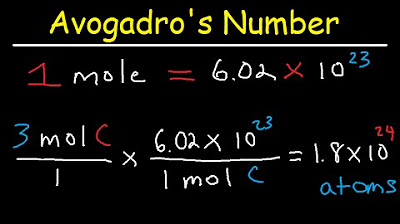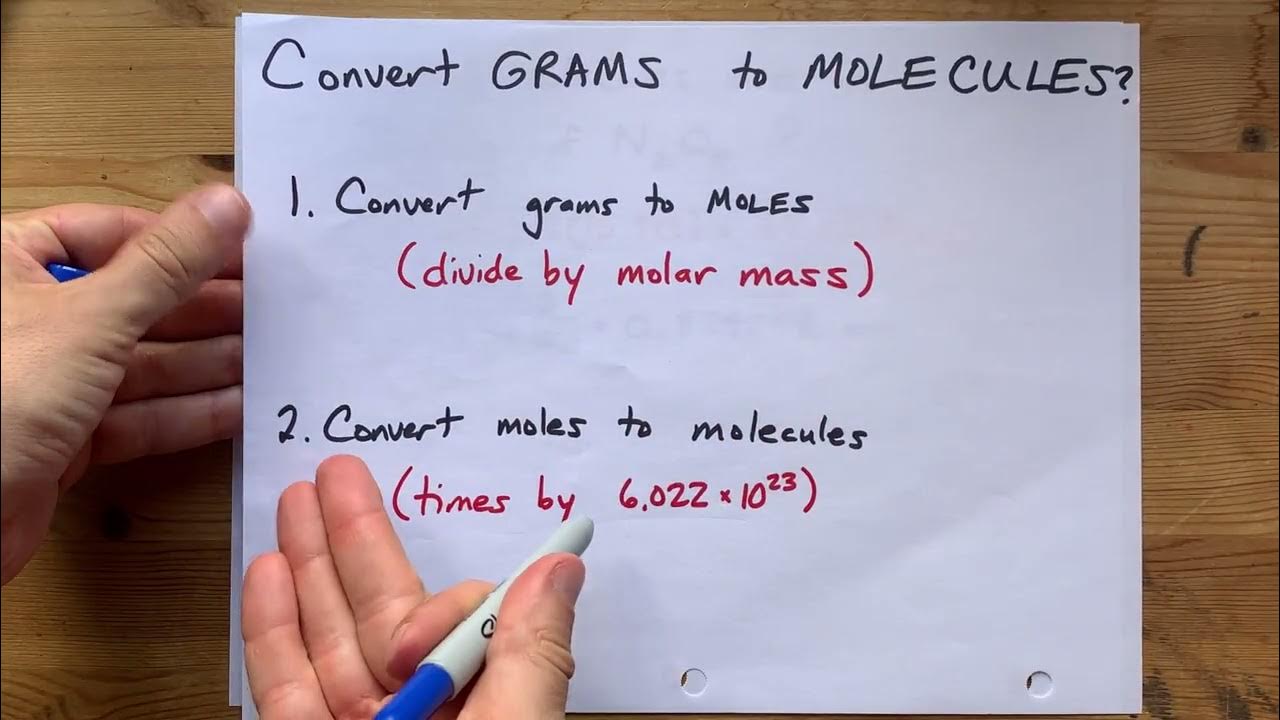NCERT Example 3.3 (Atoms and Molecules) || in Hindi for Class 9 Science
TLDRThis instructional video delves into the concept of moles in chemistry, addressing a query from two enthusiasts. It explains the significance of moles as a unit, the Avogadro's number, and the relationship between grams and atomic mass. The script guides viewers through the process of calculating moles, using helium as an example, to demonstrate how to determine the number of moles in a sample. It simplifies the concept by illustrating the atomic level and converting grams to moles, ultimately aiming to clarify the fundamental principles of moles for those unfamiliar with the topic.
Takeaways
- 🔬 The video discusses the concept of moles in chemistry, relating to the number of particles in a given sample.
- 📚 It explains that one mole is equal to 6.02×10^23 particles, which is Avogadro's number.
- 🌐 The script mentions the importance of understanding the concept of moles for various chemical calculations.
- 🧪 It illustrates the concept using helium as an example, explaining that helium is a monoatomic element with one atom per molecule.
- 🎓 The video clarifies that the atomic mass of helium is approximately 4 grams per mole, which is essential for calculating the number of moles.
- 🤔 The script poses a question about determining the number of moles in a sample, given the mass of helium.
- 📉 It uses the formula mass (in grams) / molar mass (in grams per mole) to calculate the number of moles of a substance.
- 📝 The video provides a step-by-step approach to solving the problem, starting with understanding the basic concept of moles.
- 📈 It emphasizes the significance of the mole concept in chemistry for understanding the amount of substance.
- 🔑 The video script also touches on the conversion between grams and moles, using the atomic mass unit (amu) as a reference.
- 🔗 It concludes by summarizing the key points and provides a link to a playlist of all the molecular videos in the description for further learning.
Q & A
What is the basic concept being discussed in the video?
-The video is discussing the concept of moles in the context of chemistry, specifically how to calculate the number of moles from given samples of substances like helium.
What is the significance of Avogadro's number in the context of this video?
-Avogadro's number, which is approximately 6.02 x 10^23, is used to determine the number of particles in one mole of a substance, which is essential for solving the problems presented in the video.
What is the atomic mass of helium mentioned in the video?
-The atomic mass of helium is not explicitly mentioned in the transcript, but it is implied that it is used in the calculations to determine the number of moles.
How is the mass of helium in grams related to the number of moles?
-The mass of helium in grams is related to the number of moles by using the formula: moles = mass (grams) / molar mass (grams/mole). The molar mass of helium is approximately 4 grams/mole.
What is the concept of molar mass and how is it used in the video?
-Molar mass is the mass of one mole of a substance, measured in grams per mole (g/mol). In the video, it is used to convert the mass of a sample into the number of moles by dividing the mass by the molar mass of the substance.
What is the purpose of the unified atomic mass unit (u) in this context?
-The unified atomic mass unit (u) is a standard unit for measuring the mass of atoms and molecules. It is used in the video to relate the atomic mass of helium to the number of atoms in a given mass of helium.
How many atoms are there in 1 gram of helium according to the video?
-Based on Avogadro's number, there are approximately 6.02 x 10^23 atoms in 1 mole of any substance. Since the molar mass of helium is about 4 grams/mole, there would be about 1.5 x 10^23 atoms in 1 gram of helium.
What is the significance of the number 60.02 in the video?
-The number 60.02 is not directly explained in the transcript, but it seems to be used in a calculation related to the number of atoms or moles of helium in a sample.
How does the video explain the concept of a mole in simple terms?
-The video simplifies the concept of a mole by explaining it as a count of particles in a substance, similar to counting the number of items in a collection, and using Avogadro's number as a reference for the count in one mole.
What is the final calculation presented in the video to determine the number of moles of helium in a sample?
-The final calculation involves dividing the total mass of helium in the sample by the molar mass of helium to find the number of moles. The video uses a specific example with numbers like 12.04 and 6.02 to demonstrate this calculation.
How does the video conclude the process of solving the chemistry problem?
-The video concludes by demonstrating the process of calculating the number of moles from the given mass of helium and providing the final answer, which is the number of moles present in the sample.
Outlines
🧪 Chemistry of Moles and Atomic Mass - Helium Example
This paragraph introduces the concept of moles in chemistry, specifically using helium as an example. It explains that a mole is a number that represents 6.02×10^23 entities, which is the number of atoms in 12 grams of carbon-12. The script discusses the atomic mass of helium, which is approximately 4 grams per mole, and how to calculate the number of moles in a given sample. It also touches on the concept of atomic mass and its relation to the unified atomic mass unit (u), and how to convert between grams and moles. The paragraph concludes with the calculation of the number of moles in a sample of helium, emphasizing the importance of understanding basic chemical concepts.
📚 Applying Molar Concepts to Solve Problems - Helium Sample Calculation
The second paragraph delves deeper into applying the concept of moles to solve a specific problem involving helium. It reiterates the basic formula for calculating moles and emphasizes the importance of understanding the unitary method. The script provides a step-by-step guide on how to calculate the number of moles in a given mass of helium, using the atomic mass of helium and the Avogadro's number. It also discusses the process of converting the number of moles to the actual number of helium atoms present in the sample. The paragraph concludes with the final calculation of the number of moles in a 150-gram sample of helium, demonstrating the practical application of molar concepts in chemistry.
Mindmap
Keywords
💡Mole (in chemistry)
💡Helium
💡Atomic mass
💡Avogadro's number
💡Gram
💡Molecular
💡Sample
💡Atomic level
💡Unified atomic mass
💡Number of moles
💡Mass of a sample
Highlights
Introduction to the concept of moles in chemistry.
Explanation of what a mole represents and its significance in chemical calculations.
Clarification of the numerical value of Avogadro's number and its relation to moles.
The relationship between grams and atomic mass in the context of moles.
Discussion on the atomic structure of helium and its properties as a monoatomic element.
Calculation of the number of moles from the given mass of helium.
Understanding the concept of atomic mass and its application in determining the number of atoms in a sample.
Conversion of the number of atoms to moles using Avogadro's number.
Explanation of how to calculate the mass of a sample based on the number of moles.
The importance of understanding the basic concepts of moles for solving chemistry problems.
Demonstration of the process to calculate the number of moles in a sample of helium.
Use of the formula to find the mass of a mole of helium atoms.
Conversion of the number of helium atoms to grams using the atomic mass unit.
Explanation of the concept of molar mass and its role in chemical calculations.
Illustration of how to apply the concept of molar mass to find the mass of a given number of moles.
Solving a problem involving the calculation of moles in a sample of helium using basic information.
Final summary of the process to determine the number of moles in a sample of helium and its mass.
Announcement of the next video in the series and a link to the playlist for all mole concept videos.
Transcripts
Browse More Related Video

Avogadro's Number, The Mole, Grams, Atoms, Molar Mass Calculations - Introduction

The Mole: Avogadro's Number and Stoichiometry

How many moles are in 27.0 g of H2O ?

GCSE Chemistry - The Mole (Higher Tier) #25

How many atoms of Aluminum are in 0.250 grams of aluminum?

How many molecules are in 76.3 g of N2O4 ?
5.0 / 5 (0 votes)
Thanks for rating: